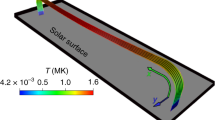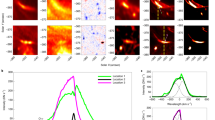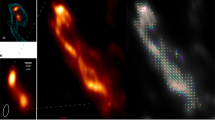Abstract
Prominences and filaments are manifestations of magnetized, levitated plasma within the solar coronal atmosphere. Their structure is assumed to be driven by the ambient magnetic field, but various open questions pertaining to their formation and evolution persist. In particular, the discrepancy between their appearance if projected against the solar disk or at the limb remain unexplained. State-of-the-art magnetohydrodynamic simulations yield a fully three-dimensional model that successfully unites the extreme ultraviolet and hydrogen Hα views of quiescent prominences that contain radial striations with the equivalent on-disk filaments comprised of finite width threads. We analyse all hydromagnetic sources of the vorticity evolution and find it consistent with the nonlinear development of the magnetic Rayleigh–Taylor instability. We show that this universal gravitational interchange process can explain the apparent dichotomy of the quiescent prominence/filament appearances. Our simulation could also be used to predict what the instruments associated with the Solar Orbiter and the Inouye Solar Telescope (DKIST) will observe.
This is a preview of subscription content, access via your institution
Access options
Access Nature and 54 other Nature Portfolio journals
Get Nature+, our best-value online-access subscription
$29.99 / 30 days
cancel any time
Subscribe to this journal
Receive 12 digital issues and online access to articles
$119.00 per year
only $9.92 per issue
Buy this article
- Purchase on Springer Link
- Instant access to full article PDF
Prices may be subject to local taxes which are calculated during checkout






Similar content being viewed by others
Data availability
All data processed within this manuscript are available online via Zenodo77.
Code availability
The open-source code for MPI-AMRVAC is available in the user files via Zenodo77 and also on the ERC Prominent website (https://erc-prominent.github.io). Visualizations were carried out within the yt-project framework (https://yt-project.org), using a modified form of the standard amrvac front-end available from the corresponding author upon request.
References
Vial, J.-C. & Engvold, O. Solar Prominences (Springer, 2015).
Zhou, Y. H., Chen, P. F., Hong, J. & Fang, C. Simulations of solar filament fine structures and their counterstreaming flows. Nat. Astron. 4, 994–1000 (2020).
Adrover-González, A. & Terradas, J. 3D numerical simulations of oscillations in solar prominences. Astron. Astrophys. 633, A113 (2020).
Wyper, P. F. et al. A model for the coupled eruption of a pseudostreamer and helmet streamer. Astrophys. J. 909, 54 (2021).
Gibson, S. E. Solar prominences: theory and models. Fleshing out the magnetic skeleton. Liv. Rev. Sol. Phys. 15, 7 (2018).
Wang, S. et al. Magnetic structure of an erupting filament. Astrophys. J. 892, 75 (2020).
Mackay, D. H., Schmieder, B., López Ariste, A. & Su, Y. Modelling and observations: comparison of the magnetic field properties in a prominence. Astron. Astrophys. 637, A3 (2020).
Hillier, A., Berger, T., Isobe, H. & Shibata, K. Numerical simulations of the magnetic Rayleigh-Taylor instability in the Kippenhahn-Schlüter prominence model. I. Formation of upflows. Astrophys. J. 746, 120 (2012).
Terradas, J., Soler, R., Luna, M., Oliver, R. & Ballester, J. L. Morphology and dynamics of solar prominences from 3D MHD simulations. Astrophys. J. 799, 94 (2015).
Alfvén, H. Existence of electromagnetic-hydrodynamic waves. Nature 150, 405–406 (1942).
Gary, G. A. Plasma beta above a solar active region: rethinking the paradigm. Sol. Phys. 203, 71–86 (2001).
Chandrasekhar, S. Hydrodynamic and Hydromagnetic Stability (Dover Publications, 1961).
Berger, T. E. et al. Hinode SOT observations of solar quiescent prominence dynamics. Astrophys. J. Lett. 676, L89 (2008).
Berger, T. E. et al. Quiescent prominence dynamics observed with the Hinode solar optical telescope. I. Turbulent upflow plumes. Astrophys. J. 716, 1288–1307 (2010).
Hillier, A., Isobe, H., Shibata, K. & Berger, T. Numerical simulations of the magnetic Rayleigh-Taylor instability in the Kippenhahn-Schlüter prominence model. II. Reconnection-triggered downflows. Astrophys. J. 756, 110 (2012).
Hillier, A. The magnetic Rayleigh-Taylor instability in solar prominences. Rev. Mod. Plasma Phys. 2, 1 (2018).
Kaneko, T. & Yokoyama, T. Impact of dynamic state on the mass condensation rate of solar prominences. Astrophys. J. 869, 136 (2018).
Berger, T. et al. Magneto-thermal convection in solar prominences. Nature 472, 197–200 (2011).
Hillier, A., Hillier, R. & Tripathi, D. Determination of prominence plasma β from the dynamics of rising plumes. Astrophys. J. 761, 106 (2012).
Jenkins, J. M. et al. Modeling the effect of mass-draining on prominence eruptions. Astrophys. J. 873, 49 (2019).
Mackay, D. H., Karpen, J. T., Ballester, J. L., Schmieder, B. & Aulanier, G. Physics of solar prominences: II—magnetic structure and dynamics. Space Sci. Rev. 151, 333–399 (2010).
Saito, K. & Tandberg-Hanssen, E. The arch systems, cavities, and prominences in the helmet streamer observed at the solar eclipse, november 12, 1966. Solar Phys. 31, 105–121 (1973).
Jenkins, J. M. & Keppens, R. Prominence formation by levitation-condensation at extreme resolutions. Astron. Astrophys. 646, A134 (2021).
Hillier, A. S. On the nature of the magnetic Rayleigh-Taylor instability in astrophysical plasma: the case of uniform magnetic field strength. Mon. Not. R. Astron. Soc. 462, 2256–2265 (2016).
Field, G. B. Thermal instability. Astrophys. J. 142, 531–567 (1965).
Claes, N. & Keppens, R. Thermal stability of magnetohydrodynamic modes in homogeneous plasmas. Astron. Astrophys. 624, A96 (2019).
Claes, N., Keppens, R. & Xia, C. Thermal instabilities: fragmentation and field misalignment of filament fine structure. Astron. Astrophys. 636, A112 (2020).
Hermans, J. & Keppens, R. The effect of optically thin cooling curves on condensation formation: a case study using thermal instability. Preprint at https://arxiv.org/abs/2107.07569 (2021).
Berger, T. E., Liu, W. & Low, B. C. SDO/AIA detection of solar prominence formation within a coronal cavity. Astrophys. J. Lett. 758, L37 (2012).
Mikić, Z. et al. Predicting the corona for the 21 August 2017 total solar eclipse. Nat. Astron. 2, 913–921 (2018).
Lemen, J. R. et al. The Atmospheric Imaging Assembly (AIA) on the Solar Dynamics Observatory (SDO). Solar Phys. 275, 17–40 (2012).
Pesnell, W. D., Thompson, B. J. & Chamberlin, P. C. The Solar Dynamics Observatory (SDO). Solar Phys. 275, 3–15 (2012).
Rochus, P. et al. The Solar Orbiter EUI instrument: the Extreme Ultraviolet Imager. Astron. Astrophys. 642, A8 (2020).
García Marirrodriga, C. et al. Solar Orbiter: mission and spacecraft design. Astron. Astrophys. 646, A121 (2021).
Zouganelis, I. et al. The Solar Orbiter science activity plan. Translating solar and heliospheric physics questions into action. Astron. Astrophys. 642, A3 (2020).
Schmieder, B. et al. Reconstruction of a helical prominence in 3D from IRIS spectra and images. Astron. Astrophys. 606, A30 (2017).
Ba̧k-Stȩślicka, U. et al. The magnetic structure of solar prominence cavities: new observational signature revealed by coronal magnetometry. Astrophys. J. Lett. 770, L28 (2013).
Harvey, J. W. et al. Full-disk solar H-alpha images from GONG. In AAS/Solar Physics Division Abstracts No. 42 17.45 (2011).
Keppens, R., Xia, C. & Porth, O. Solar prominences: ‘double, double… boil and bubble’. Astrophys. J. Lett. 806, L13 (2015).
Zhou, Y. et al. Rayleigh–Taylor and Richtmyer–Meshkov instabilities: a journey through scales. Physica D 423, 132838 (2021).
Moschou, S. P., Keppens, R., Xia, C. & Fang, X. Simulating coronal condensation dynamics in 3D. Adv. Space Res. 56, 2738–2759 (2015).
Daly, B. J. Numerical study of two fluid Rayleigh-Taylor instability. Phys. Fluids 10, 297–307 (1967).
Carlyle, J. & Hillier, A. The non-linear growth of the magnetic Rayleigh-Taylor instability. Astron. Astrophys. 605, A101 (2017).
Shelyag, S., Keys, P., Mathioudakis, M. & Keenan, F. P. Vorticity in the solar photosphere. Astron. Astrophys. 526, A5 (2011).
Canivete Cuissa, J. R. & Steiner, O. Vortices evolution in the solar atmosphere. A dynamical equation for the swirling strength. Astron. Astrophys. 639, A118 (2020).
Porth, O., Komissarov, S. S. & Keppens, R. Rayleigh-Taylor instability in magnetohydrodynamic simulations of the Crab nebula. Mon. Not. R. Astron. Soc. 443, 547–558 (2014).
Blondin, J. M. & Chevalier, R. A. Pulsar wind bubble blowout from a supernova. Astrophys. J. 845, 139 (2017).
Martin, T., Milisavljevic, D. & Drissen, L. 3D mapping of the Crab Nebula with SITELLE - I. Deconvolution and kinematic reconstruction. Mon. Not. R. Astron. Soc. 502, 1864–1881 (2021).
Sudnik, N. P. & Henrichs, H. F. Multiple short-lived stellar prominences on O stars: the O6.5I(n)fp star λ Cephei. Astron. Astrophys. 594, A56 (2016).
Peng, C.-H. & Matsumoto, R. Formation of galactic prominence in the galactic central region. Astrophys. J. 836, 149 (2017).
Zhang, Y., Wongwaitayakornkul, P. & Bellan, P. M. Magnetic Rayleigh-Taylor Instability in an experiment simulating a solar loop. Astrophys. J. Lett. 889, L32 (2020).
Keppens, R., Teunissen, J., Xia, C. & Porth, O. MPI-AMRVAC: a parallel, grid-adaptive PDE toolkit. Comput. Math. Appl. 81, 316–333 (2021).
Xia, C. & Keppens, R. Formation and plasma circulation of solar prominences. Astrophys. J. 823, 22 (2016).
Spitzer, L. Physics of Fully Ionized Gases (Courier Corporation, 2006).
Zhao, X., Xia, C., Keppens, R. & Gan, W. Formation and initiation of erupting flux rope and embedded filament driven by photospheric converging motion. Astrophys. J. 841, 106 (2017).
Koren, B. & van der Maarel, H. T. M. in Numerical Methods in Fluid Dynamics Vol. 414 (eds Napolitano, M. & Sabetta, F.) 110–114 (Springer, 1993).
Tanaka, T. Finite volume TVD scheme on an unstructured grid system for three-dimensional MHD simulation of inhomogeneous systems including strong background potential fields. J. Comput. Phys. 111, 381–389 (1994).
Xia, C., Teunissen, J., El Mellah, I., Chané, E. & Keppens, R. MPI-AMRVAC 2.0 for solar and astrophysical applications. Astrophys. J. Suppl. Ser. 234, 30 (2018).
Keppens, R., Nool, M., Tóth, G. & Goedbloed, J. P. Adaptive mesh refinement for conservative systems: multi-dimensional efficiency evaluation. Comput. Phys. Commun. 153, 317–339 (2003).
Rybicki, G. B. & Lightman, A. P. Radiative Processes in Astrophysics (Wiley-VCH, 1986).
Heinzel, P., Gunár, S. & Anzer, U. Fast approximate radiative transfer method for visualizing the fine structure of prominences in the hydrogen Hα line. Astron. Astrophys. 579, A16 (2015).
David, K. H. Die mitte-rand variation der Balmerlinien Hα-Hδ auf der sonnenscheibe. Mit 9 textabbildungen. Z. Astrophys. 53, 37 (1961).
Heinzel, P. & Schmieder, B. Chromospheric fine structure: black & white mottles. Astron. Astrophys. 282, 939–954 (1994).
Schwartz, P. et al. 2D non-LTE modelling of a filament observed in the Hα line with the DST/IBIS spectropolarimeter. Astron. Astrophys. 631, A146 (2019).
Kucera, T. A. in Solar Prominences Vol. 415 (eds Vial, J. C. & Engvold, O.) 79–101 (Springer Press, 2015).
Labrosse, N. et al. Physics of solar prominences: I—spectral diagnostics and non-LTE modelling. Space Sci. Rev. 151, 243–332 (2010).
Van Doorsselaere, T., Antolin, P., Yuan, D., Reznikova, V. & Magyar, N. Forward modelling of optically thin coronal plasma with the FoMo tool. Front. Astron. Space Sci. 3, 4 (2016).
Gibson, S. et al. FORWARD: a toolset for multiwavelength coronal magnetometry. Front. Astron. Space Sci. 3, 8 (2016).
Zhao, X., Xia, C., Van Doorsselaere, T., Keppens, R. & Gan, W. Forward modeling of SDO/AIA and X-ray emission from a simulated flux rope ejection. Astrophys. J. 872, 190 (2019).
Dere, K. P. et al. EIT and LASCO observations of the initiation of a coronal mass ejection. Solar Phys. 175, 601–612 (1997).
Landi, E. & Reale, F. Prominence plasma diagnostics through extreme-ultraviolet absorption. Astrophys. J. 772, 71 (2013).
Verner, D. A., Ferland, G. J., Korista, K. T. & Yakovlev, D. G. Atomic data for astrophysics. II. New analytic FITS for photoionization cross sections of atoms and ions. Astrophys. J. 465, 487 (1996).
Keady, J. J. & Kilcrease, D. P. in Allen’s Astrophysical Quantities (ed. Cox, A. N.) 94–97 (Athlone Press, 2000).
Boerner, P. et al. Initial calibration of the Atmospheric Imaging Assembly (AIA) on the Solar Dynamics Observatory (SDO). Solar Phys. 275, 41–66 (2012).
Low, B. C. & Egan, A. K. Steady fall of isothermal, resistive-viscous, compressible fluid across magnetic field. Phys. Plasmas 21, 062105 (2014).
Kaneko, T. & Yokoyama, T. Numerical study on in-situ prominence formation by radiative condensation in the solar corona. Astrophys. J. 806, 115 (2015).
Jenkins, J. & Keppens, R. Files and dataset for Jenkins & Keppens 2022: 3D prominence formation and evolution. Zenodo https://doi.org/10.5281/zenodo.6373339 (2022).
Acknowledgements
We acknowledge the open-source software that made possible the data visualizations presented within this work: Python (https://www.python.org); the yt-project (https://yt-project.org) and matplotlib (https://matplotlib.org). We thank B. Popescu Braileanu, J.-B. Durrive and N. Claes for discussions that were instrumental to the scientific rigour of the study. R.K. and J.M.J. are supported by the ERC Advanced Grant PROMINENT and joint FWO-NSFC grant number G0E9619N. This project has received funding from the European Research Council (ERC) under the European Union’s Horizon 2020 research and innovation programme (grant agreement number 833251 PROMINENT ERC-ADG 2018). This research is further supported by Internal funds KU Leuven, project number C14/19/089 TRACESpace. The computational resources and services used in this work were provided by the VSC (Flemish Supercomputer Center), funded by the Research Foundation Flanders (FWO) and the Flemish Government EWI department.
Author information
Authors and Affiliations
Contributions
J.M.J. completed the simulation and analysis. R.K. contributed to the model development and simulation evolution. J.M.J. and R.K. both contributed to the writing of the manuscript.
Corresponding author
Ethics declarations
Competing interests
The authors declare no competing interests.
Peer review
Peer review information
Nature Astronomy thanks Andrew Hillier and the other, anonymous, reviewer(s) for their contribution to the peer review of this work
Additional information
Publisher’s note Springer Nature remains neutral with regard to jurisdictional claims in published maps and institutional affiliations.
Supplementary information
Supplementary Information
Supplementary Figs. 1–9 and Discussion.
Supplementary Video 1
Filament, prominence, and field-aligned views of the formation and evolution of the simulation synthesized to appear equivalent to AIA 171 and hydrogen Hα observations.
Supplementary Video 2
A rotation around the simulation domain represented as a collection of semi-transparent, and correspondingly coloured, density isocontours.
Rights and permissions
About this article
Cite this article
Jenkins, J.M., Keppens, R. Resolving the solar prominence/filament paradox using the magnetic Rayleigh–Taylor instability. Nat Astron 6, 942–950 (2022). https://doi.org/10.1038/s41550-022-01705-z
Received:
Accepted:
Published:
Issue Date:
DOI: https://doi.org/10.1038/s41550-022-01705-z
This article is cited by
-
On the Physical Nature of the so-Called Prominence Tornadoes
Space Science Reviews (2023)



